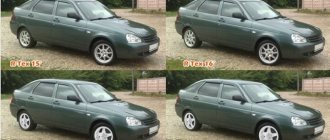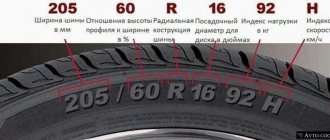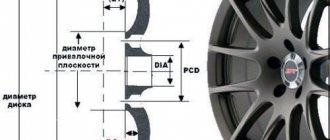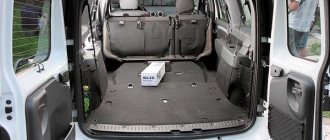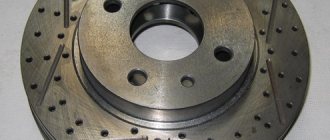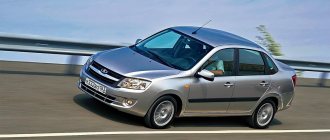A tire is not just rubber that softens the passage of uneven surfaces, but a functional design characterized by a complex structure. It ensures wheel traction on any road surface, effective braking and realizes the traction characteristics of the engine. Tires affect the vehicle's maneuverability, fuel consumption and the noise level created by the vehicle.
Wheel sizes of Lada Largus
The size of the wheels affects not only the appearance of the car, but also how it will behave on the road. AvtoVAZ indicates only one wheel size for the Lada Largus - 185/65 R15. Wheel parameters:
- 6Jx15;
- ET (departure) - 50;
- the distance between the holes for fasteners (bolt pattern) is 4x100.
Exactly the same size is indicated for Renault Logan, from which most of the components and parts for Largus were borrowed. In addition to this size, it is possible to install others:
- 185/70R14;
- 195/65R15;
- 205/55 R16;
- 205/50R17.
When choosing, keep in mind that the wheel size should not differ significantly from the standard one. Installing larger rims and tires may negatively affect the operation of the ABS and ESP systems, and their calibration will be disrupted.
Acceleration and traction characteristics are affected by the weight of the wheels - the lower this value, the faster the car will accelerate and the better it will hold the road.
The situation is different with the Lada Largus Cross in the back of a van. This model is equipped with wheels with a radius of R16 from the factory; all other parameters (offset, bolt pattern) are the same.
Features of wheels for the domestic model
In the technical manual, the inquisitive owner will find only one wheel option offered by the manufacturer - this is 185x65xR15. The factory installs stamped wheels with the specified dimensions. Since the Russian model Lada Largus is a “clone” of the Dacia Logan station wagon, produced since 2006, in the characteristics of the Romanian car you can find an indication of the identical wheel size.
The owners have gained experience installing 14-inch wheels. These products have the following dimensions - 185x70xR14. However, such wheel options are not very popular, and it is quite rare to see them on a car. Much more common modifications of r15 wheels - these are 15-inch wheels - are the following options:
- 195x55xR15;
- 205x60xR15;
- 195x60xR15.
A little less common are rims that measure 16 and even 17 inches. Among these options you can find the following standard sizes:
- 205x55xR16;
- 195x60xR16;
- 215x50xR17;
- 205x50xR17.
Well, you can’t ignore the exclusive versions with an impressive 18-inch dimensions.
This:
- 215x40xR18;
- 215x35xR18.
In the notation, R is the radius of the tire, and the numbers are the width of the tire and the height of its profile, respectively.
Selection of tires for Lada Largus
AvtoVAZ equips configurations above the base with Continental Premium Contact tires, but usually only for summer ones. For this reason, owners have a question about how to choose summer, winter or all-season tires for their car.
Selection of summer tires
Tires must match the wheel size. When choosing, the speed and weight index, brand and tread pattern are taken into account. The production date of the tires plays an important role - if they were made more than 5 years ago, it is better to refuse such a purchase.
Tread pattern
There are three types of patterns: asymmetrical, directional and symmetrical. The latter is the most popular, as it is considered universal and fits most cars. This is the best option for everyday driving around the city - without racing or off-road use. The main reason for choosing this design is its affordable price. Tires on Lada Largus with a symmetrical pattern are cheaper than all others. Such tires also have disadvantages - poor handling at high speed and wet asphalt, problems with sharp turns.
The directional tread pattern copes well with moderate off-road conditions and drains water well, showing normal handling and stability on wet road surfaces. The disadvantages include excessive noise, they cannot be placed on different sides due to strict direction, soft edges of the tread reduce directional stability.
The asymmetrical pattern shows the best characteristics: good directional stability, reduced risk of aquaplaning, you can swap wheels if necessary, increased controllability at high speed. The only drawback is the high price.
Profile height
If it is not possible to change the rims, it is recommended to install a standard tire size. Many owners strive to improve the appearance of their car. The most obvious way to do this is to install larger wheels, and this will require appropriate low-profile tires.
With a profile height of more than 60%, it is not advisable to use the car on the highway - such a tire is suitable for poor road surfaces and softens all unevenness. For driving on asphalt, it is better to use low-profile tires, as they improve dynamic performance and handling. But ride comfort is reduced - every bump will be reflected in the suspension.
Winter tires
When choosing winter tires, a lot depends on the budget, because there are European, Japanese, Chinese, and Russian brands on the market that produce tires in different price segments. For Lada Largus, it is recommended to use standard tires recommended by the manufacturer in winter. All that remains is to choose between studded and non-studded.
Handling when driving on snow is affected not by the presence of studs, but by the tread pattern. The pattern of studless rubber should contain many rectangular blocks arranged in a checkerboard pattern. The tread depth is also important - it should be at least 8 mm. The lamellas provide good grip on winter roads. Studless tires are often called “Velcro.” This is an ideal option for regions with mild winters, where ice and temperatures below 5 degrees are rather an exception. For wet snow, a tire with a directional tread pattern is suitable, as it drains water well. Advantages of studless tires:
- suitable for use on wet and dry road surfaces;
- does not make noise;
- does not have a negative impact on the road surface;
- It is resistant to high temperatures and does not impair controllability.
The main disadvantage of studless tires is their unsuitability for use on icy road surfaces. On ice and compacted snow you cannot do without tires with spikes.
The more studs on the tread surface, the better the grip on the winter road - slipping will be reduced, and the braking distance will be significantly reduced. But such tires also have their drawbacks:
- not suitable for wet snow;
- on dry or wet asphalt, the braking distance increases and the risk of skidding is higher;
- on loose snow they will not help the car to leave, but on the contrary, they will bury it even more;
- increased noise on asphalt;
- Fuel consumption increases slightly.
Despite a large number of shortcomings, it is the studded tires on the Lada Largus that have gained the greatest popularity in the middle zone and in the north, where weather conditions do not allow the use of other types of tires.
Selection of all-season tires
The niche of universal tires is occupied by all-season tires. For the most part, such tires are produced with an asymmetric tread pattern. The inner side has a rectangular pattern and is suitable for driving on snow, further increasing traction on icy roads. The outer side has a V-shaped tread, which allows you to effectively remove water from the contact patch between the tire and the road. "All-season" cars come in different types. The most popular are tires adapted for use on asphalt in the summer, but for winter roads this is not the best option. There is no point in considering off-road tires - they cannot be used on Largus, although they are considered universal for winter and summer.
On all-season tires you can find two abbreviations - All seasons or M+S (Mud+Snow - mud + snow). But these designations do not constitute official confirmation of the possibility of use in different conditions. The advantages of “all-season” tires include:
- savings - no need to buy a summer and winter set of tires, especially important if the car is not used year-round;
- the price is lower than that of specialized tires for a particular season;
- in mild winter conditions they show better performance than special kits.
This is where the advantages end; such wheels have many more disadvantages. Their main drawback is that they are equally functional in both summer and winter, losing out to seasonal products in many respects. Most of these tires are not recommended for driving at high speeds; their cross-country ability also suffers in different conditions.
All-season tires wear out quickly; buying a new set every two years is standard practice. Summer and winter sets can last 3-4 years, and with measured movement - even longer.
In harsh winters and icy conditions, driving on such wheels is unsafe and increases the risk of getting into an accident.
About summer tires for Largus 185 65 R15
According to car owners, a tire from Renault Logan 5.5×14/4×100 D60.1 ET43 is ideal, but the Lada Largus will need a tire size with parameters 185/70 R14. Factory-assembled 16-inch Largus Cross alloy wheels. They have unique parameters: width is 6 inches, drilling is 4x100, offset is ET50, CO is D60.1. The declared size of parts for the Lada Cross corresponds to 205/65 R16 tires. AvtoVAZ supplies Continental Premium Contact tires with a low profile (55% of the width).
The smaller the unsprung mass (this includes the mass of tires and wheels), the better the car will hold the road and accelerate faster. For example, if you install wheels that are 2 kg lighter each, then acceleration to 100 km/h will be reduced to 0.2 seconds.
Replacing wheels on Lada Largus
There are many reasons why you have to remove one or more wheels. This is a simple puncture, replacing brake discs or pads, suspension repairs, changing tires. Every driver, regardless of length and experience, should be able to remove and install a disc on a hub. The procedure is simple and can be done with your own hands. To change a wheel on a Lada Largus you will need a standard set of tools:
- jack;
- wheel wrench, can be replaced with a wrench with a 17 mm head.
For safety reasons, work under a vehicle that is supported only by a jack is prohibited. It is advisable to play it safe and add bricks, timber spacers and other suitable devices.
Replacement process
Using a 17 mm socket, you need to unscrew the fastening bolt that secures the spare wheel in the niche. For factory decorative caps - installed on stamped discs - you will need a special key for removal; it is included in the standard tool kit. After removing the hubcap, you need to loosen the wheel bolts using a wheelbrace. Next, the car is jacked up, the wheel bolts are completely unscrewed, and the disc is removed. Installing a new wheel is carried out in the reverse order. Forged and alloy wheels use different bolts.
Safety
The procedure for replacing wheels is not a complex operation, but even here you will need to follow basic safety rules. The vehicle must be on level ground and a hard surface. Wheel chocks must be installed under the wheels, and the machine is additionally secured with a hand brake. In addition to the jack, safety stops should be used - factory products are a priority.
Review of the best summer and winter tires
When choosing tires, owners take into account the following points:
manufacturer; operating conditions (pay attention to the pattern, tread); size; price category.
Based on reviews from Lada Largus owners, let's summarize.
The majority of survey participants adhere to the recommended sizes. The most popular non-standard tires are 195/65 R15, 195/60 R15, 205/60 R15.
Top 5 summer tires:
Nokian (HAKKA GREEN 2, Nordman SX); Michelin (Energy XM2); Continental (ContiPremiumContact 5); Matador (MP 44 Elite 3) Amtel (Planet T-301)
Attention. Complaints about rapid wear
They can burst at high speed.
The tread pattern is:
- asymmetrical;
- directed;
- symmetrical (universal, therefore the most popular).
The latter is ideal for use around the city. It has an affordable price. The downside is unsatisfactory handling at high speed, on wet road surfaces, and when making sharp turns.
Top 5 winter tires:
- Nokian;
- Michelin;
- Continental;
- Goodyear;
- Gislaved/Hankook/Bridgestone.
It is recommended to install standard winter tires. Studded or non-studded - depends on personal preferences and operating conditions. The first option is more popular among Lada Largus owners.
The pattern and tread height are important. You shouldn't skimp on winter tires.
"All-season" is not the best option. They lose to seasonal tires in most respects. In winter, there is a high risk of getting into an accident on such tires. Application. Table from the instructions.
Reading time: 5 minutes
Winter wheels on Largus are those products of various sizes that can be selected without any problems. Even novice motorists should not have any problems with this task. In this matter, the main thing is to decide on the optimal tire sizes, manufacturer’s brand and required characteristics. Unlike summer tires, for winter tires you do not need to worry about the size of the products themselves. On the contrary, it needs to be reduced as much as possible.
The presented Lada Largus Cross car from the AvtoVAZ concern, regardless of the year of manufacture, is a station wagon model and is equipped with cast wheels or stamped steel wheels in the basic versions. Steel ones are quite rare; cast versions are more common for this brand. The parameters, characteristics and recommended sizes of original winter tires must correspond to those established by the manufacturer.
Wheels for Largus Cross, winter
DIY tire replacement rules
In order to save money, many car enthusiasts are thinking about replacing tires themselves. The process is not the easiest, but doable. To work, you will need a balloon, mounting blades, a jack and a compressor or pump. When performing the procedure, you should take into account some tricks, without which this event is doomed to failure.
Removing the tire from the rim
First you need to remove the wheel from the hub. Then it is laid on the ground so that the nipple nipple is at the top. All the air is released from the tube or tire, in the case of a tubeless tire, and the nipple nipple is recessed inside. You need to stand on the wheel with your feet so that the edge of the tire separates from the rim of the disc. Sometimes extra force may be required if the rubber sticks to the metal.
A mounting blade is inserted into the gap between the edge of the tire and the disk, then a second one. The main task is to turn the sidewall of the tire beyond the edge of the rim. If the wheel has a tube, it is pulled out through the resulting gap. If the tire is tubeless, you need to unscrew the entire side of the tire by the rim, then unscrew the second sidewall of the tire using the same edge of the rim and remove it from the rim.
When working, you must apply considerable force and be careful not to damage the disc. Cast products made from light alloy materials are especially fragile.
Mounting a tire on a rim
Before installation, make sure that the tire is the correct size and has no defects. It is recommended to remove the balancing weights and the old nipple. When installing, you should take into account the markings on the tire, usually the direction of travel in the form of arrows.
To facilitate the installation task, you can apply a soap solution to the edge of the tire and the rim of the disk, but within reasonable limits, otherwise the tire will slip. Installation is carried out in the reverse order of removal. First, one edge of the tire is put on, after which the second one is wound on the rim.
How to choose the right tire diameter
The choice of tires or wheels for the Lada Largus affects not only the external design of the car, but also the behavior of the vehicle on the roads. Car manufacturers indicate acceptable dimensions. Before installing the appropriate components, you need to familiarize yourself with the basic parameters. After all, replacement of products is carried out in order to improve driving performance.
The Largus instruction manual indicates only one acceptable size - 185/65 R15. Factories install stamped wheels on Largus 15 inches. In addition to the standard size declared by the manufacturer, car enthusiasts install 14-inch tires with a dimension of 185/70 R14. Among 15-inch tires, the tires chosen for Largus are 195/65 R15; 205/60 R15, 195/60 R15 are rare.
Non-standard wheels instead of standard wheels
Sometimes owners have, for example, 14-inch stamped wheels left over from a previous car. Is it possible to install them on LADA Largus instead of the original “products”? Yes, but it will require loosening.
In such a situation, you may encounter the problem of aligning the disc with the brake caliper bracket. The fact is that the bracket sticks out in relation to the plane of contact of the disk to the hub. Moreover, if you tighten the fasteners of such a disk, it will subsequently not be able to rotate.
The same situation will happen if you install R15 wheels. They will rub against the same unfortunate bracket.
Only 16-inch ones will provide the required clearance.
If the discs have a small offset, then after installation they will provoke a change in the load applied to the wheel bearings. Also, protruding rims and tires will “throw” dirt onto the side panels of the body.
It is useful to know that a 6.5-inch disk with a 45 mm offset will touch body elements.
Standard tire parameters
The size of tires and wheel rims can have a significant impact on how a car behaves while driving. The popular universal model of domestic origin Lada Largus, as well as its off-road variation “Cross”, were no exception in this matter. Today these modifications are products of the Russian giant AvtoVAZ.
For the Largus configuration, the manufacturer uses tires produced by Amtel Planet DC. This is a domestic company owned by the Amtel-Vredestein NV corporation.
Wheels, which are stamped versions of the products, for Largus are kindly provided by the Italian manufacturer Magnetto Wheeles.
Important! For the Largus Cross option, the manufacturer uses Continental Premium Contact tires, which are manufactured by the legendary Continental AG brand.
The factory manual contains information regarding tire size options that are structurally suitable for a specific car model. Here Largus is an exception, since the manufacturer in the accompanying documentation indicated only a single option for the size of tires and wheels like them.
So, here are the parameters of the designated disks:
- product width indicator – “6J”;
- hub bolt pattern - “4x100”;
- sidewall overhang – “ET50”.
The only tire size option that the manufacturer recommends to equip various modifications of the LADA Largus is “185*65*R15”. This dimension also appears in the documentation supplied with the related model Dacia Logan MCV (2006).
What is the tire pressure
It is important to check the tire pressure level before each trip. If the value is too low:
- adhesion properties deteriorate;
- rubber may burst during a sharp turn;
- the tread wears unevenly;
- fuel consumption increases.
Excessive pressure also causes problems:
- adhesion properties with the road surface deteriorate;
- the car reacts more sensitively to all road irregularities;
- the load on the main body elements increases;
- There are extraneous noises in the cabin.
You can familiarize yourself with the recommended pressure parameters yourself. Detailed information about this is located on a special metal plate placed on the car door. For the front wheels, 2.4 bar is normal, for the rear wheels – 2.6. Moreover, the load and the number of passengers in the cabin do not have any significance.
Increasing the width of wheels and tires
As the width of the wheel and, accordingly, the tire increases, stability and controllability improve, but fuel begins to be consumed much faster.
Wide tires help to “hold” the road better, since the grip and area of the contact patch with the asphalt is larger.
Regarding the disadvantages, we note that tires with increased width are prone to aquaplaning, which is dangerous at speeds above 50 km per hour. The Lada Largus runs the risk of drifting off the trajectory when driving through large puddles at speed. There is also increased noise and increased fuel consumption. This is why the correct size of tires and wheels is so important.
Renault Duster do-it-yourself oil change video
Oil filter Renault Duster
Wipers for Renault Duster dimensions
Wheels for cars
Lada Largus is a station wagon with increased capability for transporting cargo. The car was released in 2011. The basis for the car was the Dacia Logan model, which is produced in Romania. "Largus" immediately became quite popular among car enthusiasts due to its increased capacity, low price and ease of maintenance.
Original alloy wheels "Lada Largus"
For any vehicle, wheels and tires are more than just a design element. It is on them that the behavior of the car on the road depends as much as possible. It is customary for all car manufacturers to indicate recommended dimensions for all their models. The AvtoVAZ concern is no exception.
However, it is not always and not among all manufacturers that it is customary to indicate the permissible dimensions and parameters of wheels. Often there are several options listed without specifying the minimum and maximum allowable ones. For example, in the official instruction manual for the Lada, the parameters of the wheels on the Largus are indicated in only two options:
- The usual model of the Largus station wagon should be equipped with products with a radius of R15.
- The all-terrain model "Largus Cross" is equipped with wheels size R16.
The AvtoVAZ concern does not recommend installing wheels of other sizes. Basically, they are replaced when the season changes, possible damage occurs, in which it is undesirable to use the product. In this case, replacing the disks with identical ones is explained by traffic safety.
Wheels for Lada Largus R15
Installing unsuitable wheels can affect the following characteristics:
- traffic safety;
- warranty conditions for the car, if the period has not yet expired;
- high-quality work of parts and suspension units;
- wear of chassis parts.
Since the car has become quite widespread on the roads of the country, there are many offers for the sale of wheels and tires for it. In the original configuration, the Largus is equipped with stamped wheels. In this case, many car enthusiasts are not satisfied with the appearance and characteristics of the car in motion. Then the stamped products are changed to cast or forged. Wheels on Largus size 15 are the only ones provided by the manufacturer, regardless of whether they are stamped or cast.
The Largus Cross model, even in the basic configuration, comes with installed cast parts.
Original alloy wheels on Largus Cross
If the owner has decided to replace the wheels, then there is plenty to choose from. The market offers stamped, cast and forged products of various sizes, colors and designs.
Car enthusiasts have the opportunity to purchase both original rims from the manufacturer and all kinds of replicas or used products. Various global manufacturers of cast and forged products are widely represented. These can be very popular, high-quality and expensive brands or lesser-known inexpensive ones.
As for seasonality, professionals recommend installing products with a smaller width and diameter for the winter. This is done to provide a higher level of stability on slippery roads and in bad weather. In the warm season, the size of wheels and tires does not play such a fundamental role. On the contrary, to get maximum stability and controllability, you need to choose wheels of larger diameter and width.

